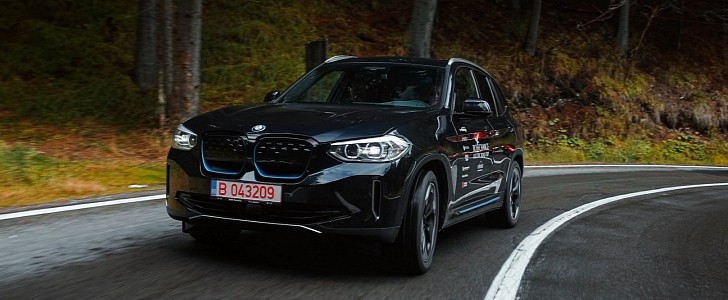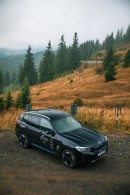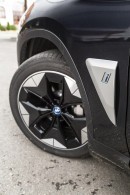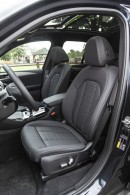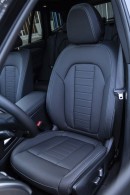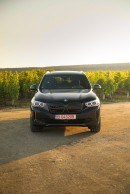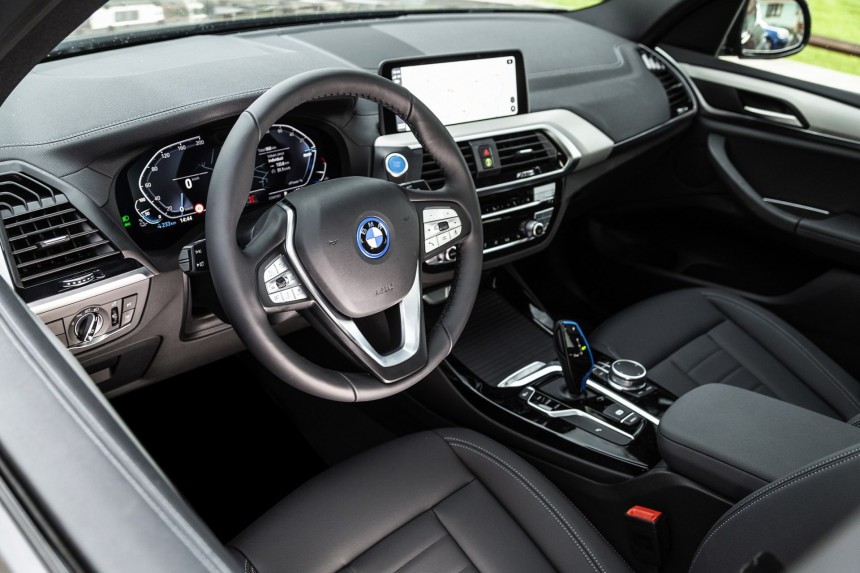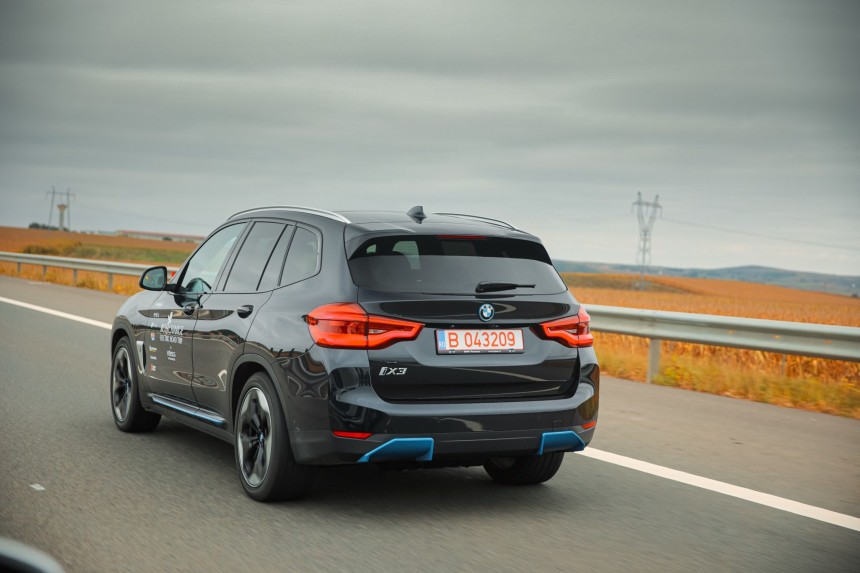The BMW iX3 demonstrates that automakers can build a car in just about any powertrain configuration one could wish for. It can be had with a gasoline engine, a diesel, a hybrid, or a fully electric version. It only lacks a hydrogen-powered model to complete the array of powertrain options on the market today. But let us focus on the BMW iX3, the electric X3 and the first electric SUV from BMW.
BMW's iX3 comes in a rear-wheel-drive configuration only. That is traditional for BMW but somewhat unexpected for a model of the X series, which used to mean that the vehicles in this line-up had xDrive all-wheel-drive as standard. Not the case for years now, but the iX3 raises the stakes by not even offering AWD as an option.
From the outside, it is easy to spot the BMW iX3, as it comes with a few extra ornaments that are finished in a particular shade of blue, and the front grille is closed off. The front and rear bumpers also have a slightly different design, but that is about it. Mind you, the blue accents are optional, so keep that in mind if you plan to order one.
On the inside, just a few elements tell you that you are, in fact, in an electric X3, not in a combustion-engined model. Otherwise, the BMW iX3 feels just like an X3, but without its combustion engine. Those who are familiar with BMWs will appreciate this aspect the most, especially if they already own one and want the iX3 as their second or third car.
From an ergonomic standpoint, the BMW iX3 gets a good score, as the German SUV has controls that are easy to use and understand. The screen on the dash does have touch controls, but you can skip those and use the iDrive instead, which operates flawlessly. The controls for volume, climate, and other relevant functions are handled through buttons, not touchscreens.
So, what is it like to drive? An extremely short answer would be, “just like a BMW X3.” That may not mean that much to those who have not driven an X3, right? Let us walk you through how the BMW iX3 is like to drive.
The steering system is adjusted for comfort, as it does not need too much force to operate. It has a certain weight to it, and that reminds us of many other BMW models, so you could say it is specific to the brand.
There is adequate feedback for the driver, but the level of feedback offered is just that. Some might consider it to be numbed, but it all depends on what it is compared to. After all, this is an SUV, not a car with sporty ambitions or anything.
The suspension of the BMW iX3 does a good job of hiding the extra weight brought by the batteries, although it is not that heavy when compared to a conventionally powered model or a hybrid X3. Thankfully for BMW, the extra weight is in the floor of the vehicle, which means that it lowered the center of gravity, and made things more manageable.
The brakes feel adequate for the power level offered and the weight of the vehicle, even though the electric motor does most of the slowing down. The transition between regenerative and hydraulic braking is almost imperceptible to the average user.
Regarding the powertrain, the BMW iX3 is only offered with a single electric motor, which powers the rear wheels. With 286 PS (281 hp) and 400 Nm (295 lb.-ft), you cannot say it is underpowered. BMW lets the e-motor do its thing, even if it is not in Sport mode. When the latter is selected, you feel the full might of the iX3.
The BMW iX3 uses a current-excited synchronous motor, which works without magnets, thus eliminating the need for rare earth metals in its construction, as the manufacturer notes. That fact might be related to the following, which is that the BMW iX3 is very good at coasting.
Once you take your foot off the accelerator and have the car in D instead of B, the German SUV does a fine job at keeping its speed. You then just need to gently press the right pedal to maintain your desired speed, which comes at rather low energy consumption, as you can observe on the digital gauge cluster.
As for the estimated range, BMW's iX3 has a maximum range of 453 kilometers (281 miles) in the WLTP cycle, with an average energy consumption of 18.9 kWh/100 km (62 miles). We started our drive with the battery charged at 96 percent, and the car displayed a range of 332 kilometers (206 miles).
After 125 kilometers (77 miles), most of which was done on the highway, the iX3 had an average energy consumption of 21.6 kWh/100 km (62 miles). The remaining range was 208 kilometers (129 miles) after that section.
To be fair, we must note that we did a few sprints from normal highway speeds to a bit more, but nothing too crazy and without jeopardizing anyone's safety. The iX3 proved to be quick, even if you ask it to accelerate hard while driving at 62 mph (100 kph) or more. It just does it, and it does not feel slow in any way.
From that point on, we drove on national roads that occasionally went through cities, and some of those roads were downhill, as opposed to the first section, which was slightly uphill when it was not entirely flat.
We stopped our drive after 276 kilometers (171 miles), which were done with an average energy consumption of 19.5 kWh/100 km (62 miles), and an average speed of 68 kph (42 mph).
Our battery still had a charge of 22 percent when we stopped, which the car estimated to be enough for another 88 kilometers (54 miles) in the same driving conditions.
The BMW iX3's range is more than reasonable for a day-to-day commute, even for those who live outside the city they work in. However, it is not as high as one might expect from a car in this segment, with this size, and at this price point. BMW does offer a larger electric SUV, the iX, which caters to this requirement.
Even without the extra range of the iX, the BMW iX3 does a good job at being an SUV and provides a sporty drive when requested. Otherwise, it is quiet, although you can notice wind noise at speeds of over 62 mph (100 kph). The latter would also be experienced in a conventional vehicle, but the lack of engine noise in an electric vehicle makes every sound easier to notice.
From the outside, it is easy to spot the BMW iX3, as it comes with a few extra ornaments that are finished in a particular shade of blue, and the front grille is closed off. The front and rear bumpers also have a slightly different design, but that is about it. Mind you, the blue accents are optional, so keep that in mind if you plan to order one.
On the inside, just a few elements tell you that you are, in fact, in an electric X3, not in a combustion-engined model. Otherwise, the BMW iX3 feels just like an X3, but without its combustion engine. Those who are familiar with BMWs will appreciate this aspect the most, especially if they already own one and want the iX3 as their second or third car.
From an ergonomic standpoint, the BMW iX3 gets a good score, as the German SUV has controls that are easy to use and understand. The screen on the dash does have touch controls, but you can skip those and use the iDrive instead, which operates flawlessly. The controls for volume, climate, and other relevant functions are handled through buttons, not touchscreens.
So, what is it like to drive? An extremely short answer would be, “just like a BMW X3.” That may not mean that much to those who have not driven an X3, right? Let us walk you through how the BMW iX3 is like to drive.
The steering system is adjusted for comfort, as it does not need too much force to operate. It has a certain weight to it, and that reminds us of many other BMW models, so you could say it is specific to the brand.
There is adequate feedback for the driver, but the level of feedback offered is just that. Some might consider it to be numbed, but it all depends on what it is compared to. After all, this is an SUV, not a car with sporty ambitions or anything.
The brakes feel adequate for the power level offered and the weight of the vehicle, even though the electric motor does most of the slowing down. The transition between regenerative and hydraulic braking is almost imperceptible to the average user.
Regarding the powertrain, the BMW iX3 is only offered with a single electric motor, which powers the rear wheels. With 286 PS (281 hp) and 400 Nm (295 lb.-ft), you cannot say it is underpowered. BMW lets the e-motor do its thing, even if it is not in Sport mode. When the latter is selected, you feel the full might of the iX3.
The BMW iX3 uses a current-excited synchronous motor, which works without magnets, thus eliminating the need for rare earth metals in its construction, as the manufacturer notes. That fact might be related to the following, which is that the BMW iX3 is very good at coasting.
Once you take your foot off the accelerator and have the car in D instead of B, the German SUV does a fine job at keeping its speed. You then just need to gently press the right pedal to maintain your desired speed, which comes at rather low energy consumption, as you can observe on the digital gauge cluster.
As for the estimated range, BMW's iX3 has a maximum range of 453 kilometers (281 miles) in the WLTP cycle, with an average energy consumption of 18.9 kWh/100 km (62 miles). We started our drive with the battery charged at 96 percent, and the car displayed a range of 332 kilometers (206 miles).
After 125 kilometers (77 miles), most of which was done on the highway, the iX3 had an average energy consumption of 21.6 kWh/100 km (62 miles). The remaining range was 208 kilometers (129 miles) after that section.
From that point on, we drove on national roads that occasionally went through cities, and some of those roads were downhill, as opposed to the first section, which was slightly uphill when it was not entirely flat.
We stopped our drive after 276 kilometers (171 miles), which were done with an average energy consumption of 19.5 kWh/100 km (62 miles), and an average speed of 68 kph (42 mph).
Our battery still had a charge of 22 percent when we stopped, which the car estimated to be enough for another 88 kilometers (54 miles) in the same driving conditions.
The BMW iX3's range is more than reasonable for a day-to-day commute, even for those who live outside the city they work in. However, it is not as high as one might expect from a car in this segment, with this size, and at this price point. BMW does offer a larger electric SUV, the iX, which caters to this requirement.
Even without the extra range of the iX, the BMW iX3 does a good job at being an SUV and provides a sporty drive when requested. Otherwise, it is quiet, although you can notice wind noise at speeds of over 62 mph (100 kph). The latter would also be experienced in a conventional vehicle, but the lack of engine noise in an electric vehicle makes every sound easier to notice.
